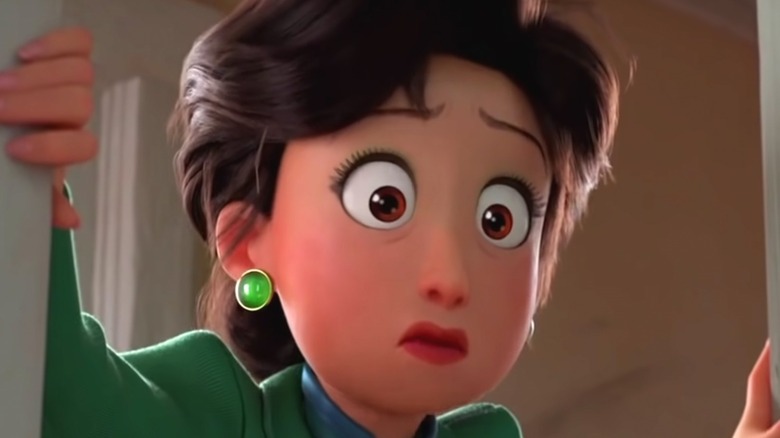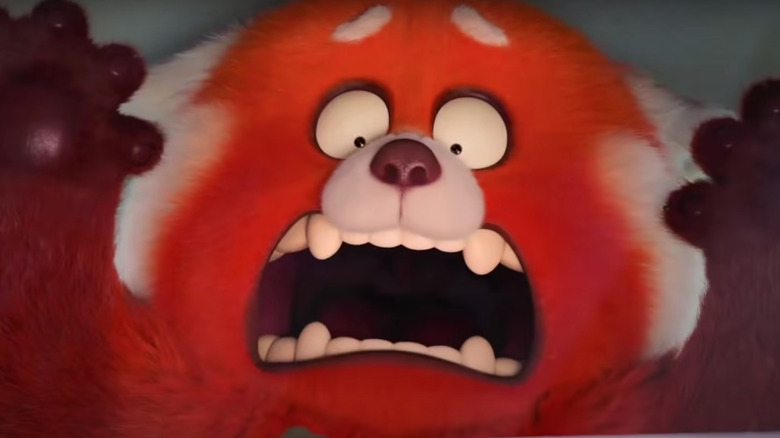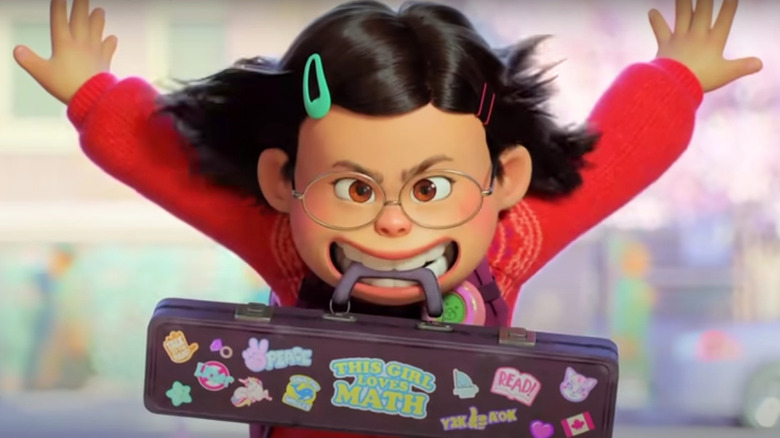Where Does Turning Red Fit Into The Larger Pixar Universe?
Fans of Pixar Animation Studios are probably largely familiar with "The Pixar Theory" or "The Pixar Universe" — which is the notion that all of the films put out by the company are interconnected through a linear timeline, and require the viewer to watch the films in a certain order to understand the studio's much larger message (per the Pixar Theory website). A series of Easter eggs, which are dotted throughout each film, form a sort of cohesive multiverse that lead viewers from "Brave" to "WALL-E," and features pitstops for time travel, magical interference, and a near-apocalypse. Folks who work at Pixar tend to downplay this widespread theory; for example, per a Movies.com interview, "Monsters University" co-producer Kori Rae said Pixar's multiple production teams "would've had to be insane geniuses to have plotted [the theory] out."
Whether one believes that the connected Pixar universe is real or just make-believe, fans of the theory might be excited to figure out how and where "Turning Red," Pixar's latest release, fits into the larger Pixar Universe. Here's what we've been able to suss out.
You can probably watch Turning Red after Inside Out
"Turning Red" is set in Toronto, Canada in 2002. In terms of continuity, you should be able to comfortably slide it either between "Toy Story" and "Toy Story 2" or watch it directly afterwards, but we're going to get a little more bold with our take on the theory.
Both "Toy Story" films are set around the time period they were released: the mid and late 1990s, respectively. While "Finding Nemo" is also contemporaneous to its 2003 release date, in accordance with the Pixar Theory, one should watch it after 2009's "Up," then follow it with "Finding Dory" and "Inside Out." Due to the inclusion of a sticker featuring a rainbow unicorn — a character seen in "Inside Out" — and the presence of a bird skeleton which closely resembles Kevin from "Up," we're going to say you should watch "Turning Red" after "Inside Out."
In "Turning Red," the continuance of magic usage as represented by Mei (Rosalie Chiang) and the other women in her family's ability to take on animal forms and use a form of astral projection adds another piece to the theory. A similar type of astral projection is seen in the film "Soul," and the Pixar Theory fans connect this magical ability all the way back to Merida's meeting with the Will O' the Wisps in "Brave." This shows a linear strengthening of such powers as originated in the universe by "Brave," but it is not quite what it would become in "Soul," lending credence to the notion that "Soul" should be watched after "Turning Red."
Do any of the film's Easter eggs provide further clues?
There are small callbacks and Easter eggs featuring items and characters from other Pixar films in "Turning Red," but none of them are as important to the theory as the "Inside Out" and "Up" ones. Also included in the film are references to the Pixar shorts "Bao," "Burrow," and "Purl," as well as a sticker of a clownfish which resembles Nemo from "Finding Nemo."
The movie also has three classic Easter eggs which appear in almost every Pixar film: one can spy a Pizza Planet truck (a staple of all Pixar films since "Toy Story" spotlighted the restaurant) in the background of Mei's race to get to Toronto's Sky Dome in time for the 4*Town concert; the numerical code A113 pops up on a 4*Town ticket, which references a classroom attended by lots of Pixar alumni who attended the California Institute of the Arts; and the ball squashed by Luxo Jr. — the studio's signature lamp character — in the Pixar Studios logo can be seen in a swimming pool.
Since none of these references add on to the theory, we're gonna stick with our notion that Pixar fans should watch "Turning Red" in the middle of the pack. Any way you slice it, "Turning Red" is definitely turning heads, theories believed or disproven.


